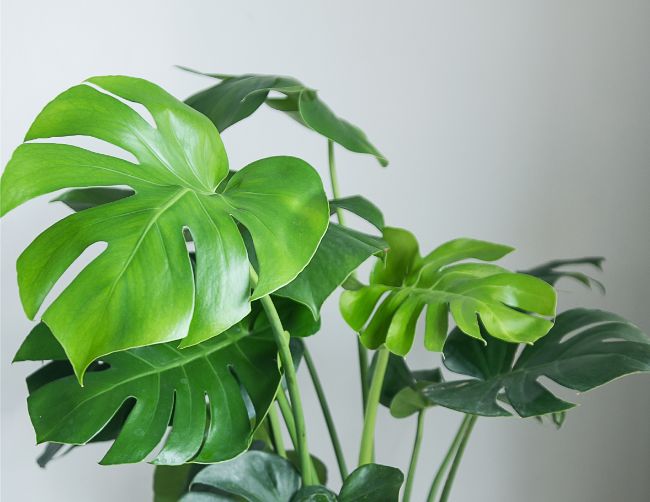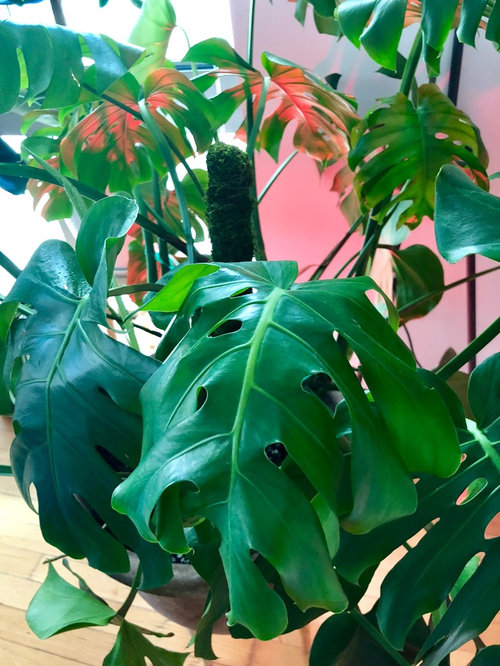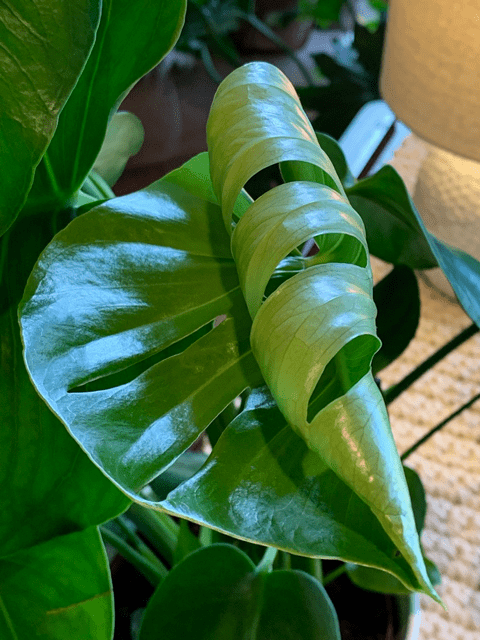Monstera plants are known for having big, beautiful, fenestrated leaves that look like they have many different parts. If a Monstera isn’t happy with its environment or cared for, the leaves are the first thing you’ll notice.
Curled leaves are one of the many ways a Monstera might show that it needs to change. There are a lot of different reasons why the leaves of a Monstera plant might curl. You might need to do some sleuthing and use the elimination process to figure out what’s causing it.
In general, the leaves of monsteras curl so that less surface area is exposed and less water is lost through transpiration. This usually means that, for some reason, water loss is a problem. This could be because of heat stress, underwatering, damaged roots, or insect infestation that drains water from the plant.

In what ways are your monster leaves curled?
Monstera leaves start to curl inwards.
If your monstera’s leaves are curling inwards or up toward the top of the leaf, this could be a sign that your plant isn’t getting enough water, there isn’t enough humidity, or there are bugs living in it.
Leaves from Monstera are curling down.
There are a lot of different reasons why monstera leaves can curl under at the bottom of the leaf. Sometimes this can be a sign of heat stress or underwatering if the leaf doesn’t have enough turgor pressure. Leafy plants may have thin, limp leaves that look like they’re drooping.
A Monstera leaf is crinkling.
Dry or browning edges are usually a sign that the plant has been underwatered or there isn’t enough humidity. Crinkled, brittle leaves are usually a sign of that.
This is how you can figure out why your Monstera is stressed.
Reasons for Monstera Leaves Curling
Overwatering
Overwatering and wet soil could hurt the plant’s roots and eventually kill it. The best place to start is to check the soil. If the soil still feels wet an inch or two down and you watered at least a few days ago, your soil might be holding on to too much water. Remember, too much water can make leaves that look soft when you touch them wilt and turn yellow.

During this time, you should only water your plant when the topsoil feels dry to the touch. If your plant has already shown signs of overwatering, then stop watering for a while. You can also take the plant out of the pot and cut off the damaged roots that have grown. A new potting mix should be added to the old one.
Underwatering
Shriveled leaves on Monstera are a sign that you might not be watering it enough. One of the first things you’ll probably notice is that the soil looks dry. Feel the soil with your finger. Underwater, your monstera uses its natural defense mechanism to save water and stay alive. When the leaves are crinkled, it takes up less space for the plant to lose water.
For immediate moisture fix Soak the soil with water for a few minutes, then let it sit until the water drains completely. Rather than following a set schedule, you should follow the same process every time to see if it needs a drink. Slowly add water until it seeps out of the drainage holes. Empty the tray right away. Make sure to water the soil, not just the leaves.
Make sure your plant needs water before you do. Then, put your finger or a wooden stick about 2-3 inches into the soil.
If it doesn’t come out wet, your Monstera needs to drink. Wait a few days if it’s wet and has clumps of soil.
We suggest that you use a moisture meter to get a more accurate picture of how much moisture your soil has. If your soil isn’t well-aerated, the root ball could be wet even if the top few inches of soil feel dry to the touch.
Light exposure
Plants can be hurt by too much or too little light. Direct sunlight burns the plant’s leaves, making them curl inward. And the tips of the leaves may turn brown.
Putting a sheer curtain or moving your plant away from the light source might help. The light won’t be so direct and hit your plant’s leaves so hard!
Low Humidity
Monsteras do best when the humidity level is between 40% and 45%. The ideal level would be around 60%.
Heat from a heater, fireplace, or heating vent can also make the leaves of monstera turn yellow and curl. If your plant’s leaves start to curl up very quickly, this could be the problem. It can also dry out a plant’s leaves when there is a lot of heat.
Here, the answer is simple: if your plant’s leaves start to curl, check for a hot draft and move your plant right away.
Keep a humidifier near the plant, move the plant to a steamy bathroom with indirect sunlight, group the plant with other houseplants, or put the plant on a humidity tray. At a garden store, you can buy these, or you can make your own by filling a shallow tray with water and pebbles, then putting your plant on top of it.

Pests are an issue.
Some bugs, like mealybugs, spider mites, and thrips, can eat the plant’s stems and leaves, making the leaves curl and die.
Spider mites are hard to find because they are small and easy to miss. If you look carefully, you will be able to find them and other pests. Look for any small yellow spots or rings that form on the leaves in an irregular way.
How can you get rid of pests?
When you see any pests, just separate that plant from the rest of your houseplants. Then, use insecticidal soap, pesticide, or organic neem oil mixed with dish soap to get rid of the bugs that are on them.
Most monstera plants have leaves that curl up when they don’t get enough water or aren’t getting enough humidity. Before you get into more specifics, keep these two common problems in mind.

